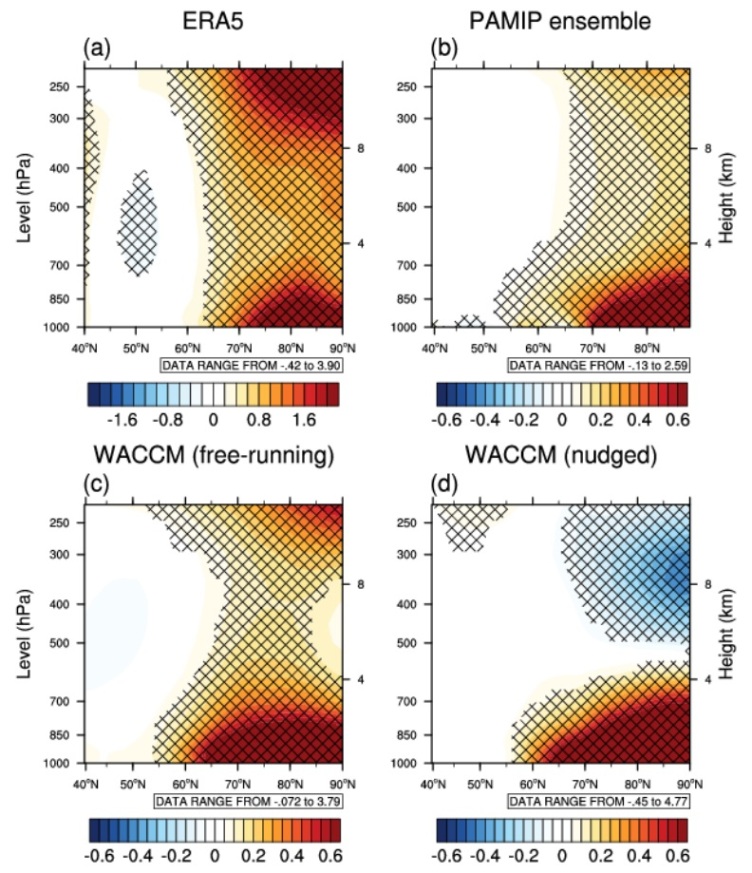In the past decade, the middle latitudes of the northern hemisphere have been frequently attacked by extreme cold events (such as the snow disaster in southern China in 2008, the 'overlord' cold wave in 2016, and the 'beast' cold wave in Europe in 2018). These events have caused serious casualties and huge economic losses. Previous studies have shown that the sharp decline in Arctic sea ice is one of the causes of these extreme cold events, but the link between the two is still highly controversial and has many unresolved issues. Recent studies have shown that the warming anomaly throughout the entire Arctic troposphere (below 10 km above the ground), namely deep warming, can stimulate a strong cooling in winter mid-latitudes, while the warming anomaly limited to the polar surface, that is, shallow warming, causes weak cooling. Therefore, the Arctic warming vertical structure may be the key link between Arctic sea ice and mid-latitude weather and climate, but the connection between sea ice and the Arctic warming vertical structures mentioned above has not been clarified. In addition, previous studies have pointed out that the interaction between the stratosphere (10-50 km from the ground) and the tropospheric atmosphere plays an important role in the connection between sea ice and mid-latitude weather and climate, but the role of this interaction in the possible impact of sea ice on the warming vertical structure of the Arctic is not yet determined.
To solve the above problems, recently, Professor Tian Wenshu's research team from the College of Atmospheric Sciences of Lanzhou University and foreign collaborators published Important role of stratosphere-troposphere coupling in the Arctic mid-to-upper tropospheric warming in response to in npj Climate and Atmospheric Science (Climate and Atmospheric Science) Sea-ice loss (the important role of stratosphere-troposphere coupling in the upper Arctic troposphere warming caused by sea ice reduction) The important contribution of Arctic sea ice reduction and stratosphere atmospheric feedback are found.
Research has found that as Arctic sea ice decreases, there will be a deep warming in the Arctic region (see Figure 1a-c). The study also found that when feedback from the stratospheric atmosphere is not taken into account, the Arctic warming caused by sea ice reduction is limited to the lower troposphere, i.e. shallow warming (see Figure 1d), indicating that the interaction between the stratosphere and troposphere plays an important role in the Arctic deep warming caused by sea ice. Their research not only reveals the importance of feedback from the stratospheric atmosphere in Arctic warming, but also provides new scientific evidence for the connection between Arctic sea ice and mid latitude weather and climate proposed in recent years, which helps to improve the short-term climate prediction level of extreme cold weather by utilizing Arctic sea ice and stratospheric processes. The lead author of this paper is Xu Mian, a doctoral candidate from the College of Atmospheric Sciences of Lanzhou University, and the corresponding author is Professor Tian Wenshou and Professor Zhang Jiankai.

Figure 1. (a) Regression coefficient distribution of BKS sea ice density for winter zonal average temperature from 1979 to 2020 obtained from ERA-5 reanalysis data, and multiplied by the difference in density between BKS low and high sea ice years. (b) The difference in winter zonal temperature between the pdSST futBKSeaSIC and pdSST pdSIC experiments obtained from the PAMIP multimodal large set simulation. The difference in winter zonal temperatures between the BKS low sea ice and high sea ice experiments using the SC-WACCM model of (c) free running and (d) nudge Arctic stratospheric polar vortex, respectively. The black grid area indicates that the difference has passed the Bootstrap resampling test at a 90% level.
This research achievement has been supported by the National Natural Science Foundation of China (42071296 and 41930111) and the Central University Basic Research Business Fee Special Fund (lzujbky-2022-09).
